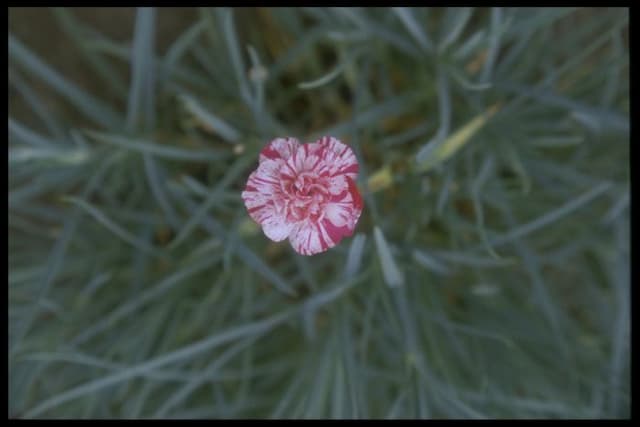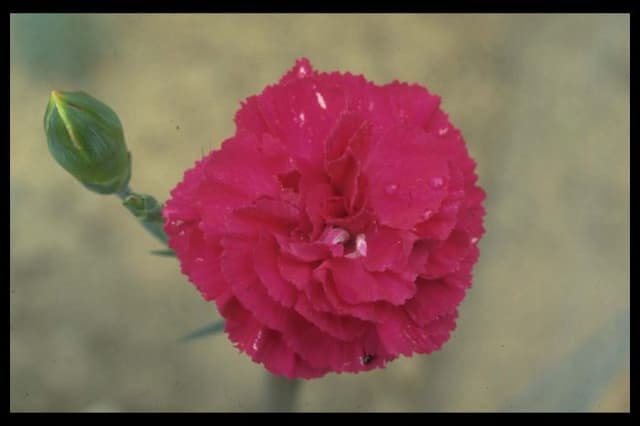Carnation Dianthus 'Pennine Treasure' (b)

ABOUT
The Dianthus 'Pennine Treasure' is known for its strikingly beautiful and sweetly fragrant flowers. The blooms display a rich palette of colors, typically ranging in various shades from soft pinks to bold reds, often with a unique pattern of concentric rings or a contrasting eye at the center. They bear a textured, fringed look on the edges, which gives them an elegantly ruffled appearance that can feel soft to the touch. The petals can be singular or layered and are held high above the foliage on sturdy stems, inviting admiration and adding a touch of class to any garden display. The leaves of Dianthus 'Pennine Treasure' are typically slender and blade-like, boasting a blue-green to gray-green color that forms a neat, low-growing tuft or a dense clump. The foliage often remains evergreen throughout the year in certain climates, providing a permanent backdrop for seasonal blooms. This visual contrast between the delicate, vivid flowers and the grounding, muted tones of the leaves create a particularly attractive display. The plant's overall form is compact and bushy, giving it a full and luscious look even when not in bloom. The Dianthus 'Pennine Treasure' is a feast for the senses, with its eye-catching looks and a delightful fragrance that can perfume the air, especially on warm days.
About this plant
 Names
NamesFamily
Caryophyllaceae
Synonyms
Cheddar Pink, Clove Pink, Gillyflower, Pinks
Common names
Dianthus 'Pennine Treasure'
 Toxicity
ToxicityTo humans
The Dianthus, commonly known as carnation or clove pink, is not considered toxic to humans. In general, these plants do not present a risk of poisoning upon ingestion. However, some people may experience a mild dermatitis or allergic reaction when handling the plant due to skin sensitivities.
To pets
Dianthus, or carnation, is not highly toxic to pets. While it doesn't generally cause severe poisoning, ingestion can sometimes lead to mild gastrointestinal upset in animals such as vomiting or diarrhea. If a pet displays symptoms after ingesting any part of the plant, it is advisable to consult a veterinarian.
 Characteristics
CharacteristicsLife cycle
Perennials
Foliage type
Evergreen
Color of leaves
Blue-green
Flower color
Varies
Height
1 foot 6 inches (45 cm)
Spread
1 foot (30 cm)
Plant type
Herb
Hardiness zones
5
Native area
Europe
Benefits
 General Benefits
General Benefits- Aesthetic Appeal: The Dianthus 'Pennine Treasure' adds striking color and beauty to gardens with its vibrant flowers.
- Attracts Pollinators: The blooms attract beneficial insects such as bees and butterflies, promoting pollination in the garden.
- Fragrant Flowers: The flowers emit a pleasant fragrance which can enhance the sensory experience of a garden or outdoor space.
- Extended Blooming Season: This plant often has a long flowering period, providing color for a significant portion of the growing season.
- Drought Tolerance: Once established, they are relatively drought-tolerant, making them suitable for xeriscaping or low-water gardens.
- Easy to Grow: Dianthus varieties are generally easy to care for, making them suitable for novice gardeners or those with limited time for maintenance.
- Cut Flowers: The flowers can be cut and used in floral arrangements, adding a fresh look and fragrance indoors.
- Ground Cover: Low-growing varieties can be used as ground cover, helping to suppress weeds and reduce soil erosion.
- Border Planting: With its compact growth habit, it is well-suited for borders or edging in garden design.
- Container Gardening: It's suitable for growing in pots or containers, adding versatility to its placement and use in various garden settings.
 Medical Properties
Medical PropertiesThis plant is not used for medical purposes.
 Air-purifying Qualities
Air-purifying QualitiesThis plant is not specifically known for air purifying qualities.
 Other Uses
Other Uses- Carnation 'Pennine Treasure' can be used as a natural fabric dye, with its petals providing a range of pink to light-red hues depending on the mordant used.
- The flowers are sometimes used in the art of flower pressing to create decorative bookmarks, cards, or in other paper crafts for their vivid colors and pleasing shape.
- In culinary arts, the petals of the Carnation 'Pennine Treasure' may be candied for cake decoration or dessert garnishing, offering a sweet and slightly spicy flavor.
- They can be added to potpourri mixes for their fragrance and to impart a touch of color in the mixture.
- Petals of the Carnation 'Pennine Treasure' can be used to make natural confetti for weddings and celebrations, as they are biodegradable and colorful.
- The edges of Carnation 'Pennine Treasure' petals can be used in craft projects to create floral imprints on clay or ceramics before firing.
- These flowers may be distilled to make a fragrant floral water that can be used as a scented rinse for linens or as a mild room spray.
- Carnation 'Pennine Treasure' petals can be incorporated into homemade soaps for their color and subtle fragrance, giving the final product a natural appeal.
- Flowers from the Carnation 'Pennine Treasure' can be used in the creation of natural inks for calligraphy, with the shade adjusted by altering the preparation process.
- Gardeners may use dried petals as a decorative mulch for potted plants, providing visual interest while helping to retain soil moisture.
Interesting Facts
 Feng Shui
Feng ShuiThe Dianthus or Carnation is not commonly referenced in Feng Shui practice.
 Zodiac Sign Compitability
Zodiac Sign CompitabilityThe Carnation is not used in astrology practice.
 Plant Symbolism
Plant Symbolism- Divine Love: The name Dianthus comes from the Greek words 'dios' (godly) and 'anthos' (flower), suggesting a divine or heavenly form of love.
- Boldness: These flowers are often associated with boldness due to their bright, striking colors and the rich, spicy fragrance they emit.
- Pure Affection: Carnations, in general, symbolize love and fascination, which translates to a pure and deep affection when considering the Dianthus.
- Longevity and Good Health: Due to their long-lasting nature, carnations often represent health and longevity.
 Water
WaterFor Dianthus 'Pennine Treasure', commonly known as Cheddar Pink, it is important to maintain consistently moist soil without overwatering. Water the plant thoroughly once the top inch of soil feels dry to the touch, which typically means watering every one to two weeks, depending on the climate and soil drainage. Use a gentle stream of water to soak the soil around the plant, being careful to avoid wetting the foliage which can promote disease. In terms of quantity, provide about one gallon of water every 7 to 10 days during active growth in spring and summer. Adjust the watering frequency and amount during cooler months when the plant is not actively growing, ensuring soil remains slightly moist but not waterlogged.
 Light
LightCheddar Pink thrives best in full sun to partial shade conditions. The ideal location for this plant is a spot that receives at least six hours of sunlight each day, preferably morning sun with some afternoon shade to protect from the intense heat of the day. Well-lit areas that offer bright, indirect sunlight can also be suitable, ensuring the vibrant colors of the blooms are maintained.
 Temperature
TemperatureCheddar Pink prefers a temperate climate with temperatures ranging between 50°F and 85°F. While it can tolerate temperatures as low as the high 30s°F for brief periods, prolonged exposure to freezing temperatures can be harmful. The ideal temperature for this plant is between 60°F and 75°F for optimal growth and flowering. It is important to protect the plant from extreme heat or cold to prevent stress and damage.
 Pruning
PruningPruning Cheddar Pink is important to encourage a bushy growth habit and to maintain a tidy appearance. Remove spent flowers regularly to promote continuous blooming throughout the growing season. Pruning is best done after the main flowering period has ended, typically done in late summer or early fall. Cutting back the plant by one-third of its height will help to stimulate new growth and prepare it for the next blooming cycle.
 Cleaning
CleaningAs needed
 Soil
SoilThe best soil mix for the Pinks (Dianthus) is well-draining, sandy loam with plenty of organic matter, ensuring a neutral to slightly alkaline pH of 6.75 to 7.5.
 Repotting
RepottingPinks (Dianthus) typically do not require frequent repotting and can be done every two to three years, or as needed if the plant outgrows its container.
 Humidity & Misting
Humidity & MistingPinks (Dianthus) prefer average to low humidity levels and do well in outdoor conditions with natural air circulation.
 Suitable locations
Suitable locationsIndoor
Provide bright light and good air flow for indoor Pinks.
Outdoor
Plant in full sun, in well-drained soil for outdoor Pinks.
Hardiness zone
4-9 USDA.
 Life cycle
Life cycleThe life cycle of the Dianthus 'Pennine Treasure', commonly known as Dianthus, begins with seed germination, where the seeds require a well-drained soil mix and a stable temperature to sprout. Once germinated, the seedlings grow into young plants with characteristic bluish-green leaves and must be gradually acclimatized to outdoor conditions if started indoors. As the plants mature, they develop a sturdy root system and a clumping growth habit, with flowering typically occurring in late spring to early summer, showcasing fragrant, vibrant blooms that attract pollinators. After the blooming period, the Dianthus 'Pennine Treasure' may produce seeds, which can be collected for propagation or left to self-sow if conditions are favorable. To maintain vigor, the plants should be deadheaded to encourage further blooming and to prevent excessive self-seeding. Finally, as perennial plants, they will enter a period of dormancy in the winter, where they conserve energy before resuming growth in the spring.
 Propogation
PropogationPropogation time
Spring-Early Summer
Propogation: Dianthus 'Pennine Treasure', commonly known as a variety of Garden Pink, is typically propagated through cuttings, particularly during early summer when the plant's growth is most vigorous. To propagate through cuttings, a gardener should select a healthy non-flowering shoot and cut a piece about 3 to 4 inches in length (approximately 7.5 to 10 centimeters). It is important to make a clean cut just below a node, the point on the stem where leaves emerge. After removing the lower leaves, the cutting should be dipped in a rooting hormone powder to encourage root development. The prepared cutting can then be inserted into a pot filled with a mix of sand and peat to provide good drainage and moisture retention. The cutting needs to be kept in bright, indirect sunlight and maintained at a consistent moisture level until the roots have established, which typically takes several weeks. After rooting, the young plant can be transplanted to a more permanent location in the garden or container.
![Pink [Cherry Daiquiri]](/_next/image?url=https%3A%2F%2Fplants-admin.emdemapps.com%2Fimages%2Fplants%2F%2Fimages%2F604b53704a83a.png&w=640&q=75)

![Pink [Silver Star]](/_next/image?url=https%3A%2F%2Fplants-admin.emdemapps.com%2Fimages%2Fplants%2F%2Fimages%2F604b61705f0a1.png&w=640&q=75)
![Perpetual-flowering carnation [Viana]](/_next/image?url=https%3A%2F%2Fplants-admin.emdemapps.com%2Fimages%2Fplants%2F%2Fimages%2F604b63fe46ad4.png&w=640&q=75)





